I Tested the Through The Wall Mailbox: My Honest Review and Installation Tips
I’ve always been fascinated by clever home features that blend convenience with style, and one that’s recently caught my attention is the through the wall mailbox. It’s more than just a simple slot for mail—it’s a smart solution that brings a touch of modern efficiency right to your doorstep. Whether you live in a bustling…
